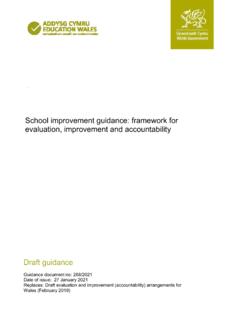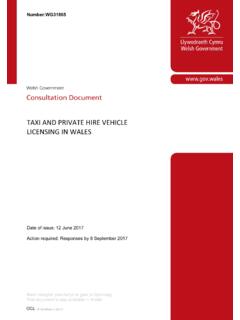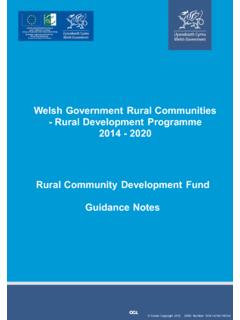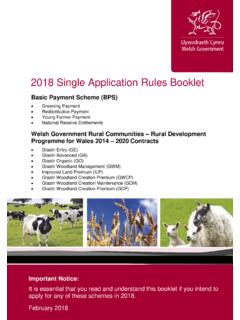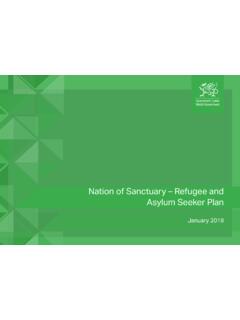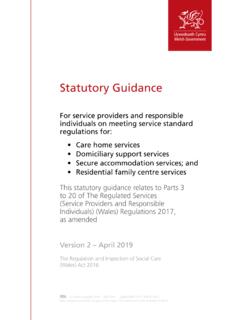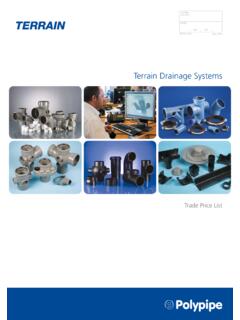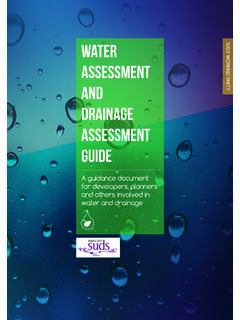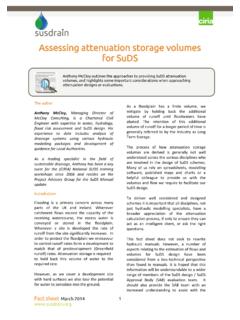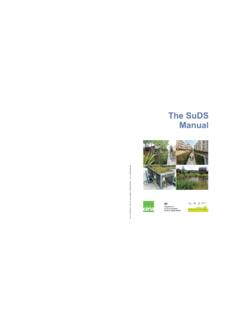Transcription of Statutory standards for sustainable drainage systems ...
1 Statutory standards for sustainable drainage systems designing, constructing, operating and maintaining surface water drainage systems2018 Crown copyright 2018 WG36005 Digital ISBN 978 1 78964 148 6 Mae r ddogfen yma hefyd ar gael yn Gymraeg / This document is also available in drainage systems standards for Wales Page 1 of 63 Contents 1. Introduction 2. Principles 3. standards and Guidance S1. Surface water runoff destination S2. Surface water runoff hydraulic control S3. Water Quality S4. Amenity S5. Biodiversity S6. Design of drainage for construction, operation and maintenance 4. Regulatory framework 5. Glossary 6. Additional referencesSustainable drainage systems standards for Wales Page 2 of 63 1. Introduction The Flood and Water Management Act 2010 (Schedule 3), which comes into effect in Wales on 7 January 2019, requires new developments to include sustainable drainage systems ( suds ) features that comply with national standards .
2 The Welsh Government published interim national standards on an advisory basis in January 2016. Our aim was to enable designers; property developers; local authorities and other interested parties to both demonstrate that they have taken account of the Welsh Government s planning advice on Development and Flood Risk1, Nature Conservation and Planning2 and to test the standards , so that if necessary they could be revised before being placed on a Statutory footing. Following consultation through 2017, the Welsh Ministers have now commenced Schedule 3 with effect from 7 January interim non Statutory national standards and guidance have formed the basis for these Statutory standards , with minor amendments to take into account comments received throughout the consultations. They are for the design, construction, operation and maintenance of suds serving new developments in urban or rural areas of more than one dwelling or where the area covered by construction work equals or exceeds 100 metres squared.
3 They provide information for designers, property developers, local authorities and other interested parties, such as sewerage undertakers and Natural Resources Wales (NRW). They also contain links to additional supporting information relating to suds . The Welsh Ministers Statutory standards for suds are contained within grey boxes, with clauses prefixed by the letter S. The Welsh Ministers guidance is given below the standards and has clause numbers prefixed with the letter G. The guidance is not intended to be comprehensive, as there are many sources of technical information available, in particular the CIRIA suds Manual3 . Although these standards apply for new developments, the suds approach is increasingly being applied to existing developments to address sewerage capacity and local flood risk problems. These standards can provide a useful framework for the delivery of such retro-fit schemes. From 7 January 2019, new developments of more than one dwelling or where the area covered by construction work equals or exceeds 100 square metres require approval before construction can commence from the suds Approval Body (SAB).
4 Adoption and management arrangements, including a funding mechanism 1 2 3 sustainable drainage systems standards for Wales Page 3 of 63 for maintenance of suds infrastructure and all drainage elements are to be agreed by the SAB as part of this approval. This will ensure that suds infrastructure is properly maintained and functions effectively for its design life. Although these standards apply for developments which include road drainage , they are not intended to be applied to the trunk road network managed by the Welsh Government. Equivalent provision for suds for these roads is contained in Volume 4 of the Design Manual for Roads and Bridges4. The Planning (Wales) Act 2015 introduced a Statutory purpose for the planning system . Any Statutory body carrying out a planning function must exercise those functions in accordance with the principles of sustainable development as defined in the Well-being of Future Generations Act 2015.
5 The Well-being of Future Generations (Wales) Act 2015 places a duty on public bodies that they must carry out sustainable development. This means the process of improving the economic, social, environmental and cultural well-being of Wales by taking action, in accordance with the sustainable development principle, aimed at achieving the well-being goals. The use of suds is a way of helping to achieve sustainable development in both new and existing developments. A natural approach to managing rainwater The suds approach mimics natural drainage , managing surface runoff at or close to the surface and as close to its source as practicable, controlling the flow (volume and rate of runoff) and providing a range of additional benefits. It contrasts with traditional drainage techniques, which are based on underground pipes to convey rainwater away from properties as quickly as possible. While pipes will often be used in suds drainage schemes, the construction of surface water drainage systems comprising solely of pipe sewers will be the exception.
6 The most effective suds use a series of various drainage components (where possible vegetative units), operating as close to the source of runoff as practicable. These should work as a suds management train (see glossary) to control flow rates and reduce volumes of runoff, providing treatment to protect water quality and opportunities to encourage biodiversity and amenity. Well designed, easy to maintain suds will deliver a range of important benefits for the local environment, the development and local communities. They can: contribute to the delivery of Water Framework Directive, local flood risk management, Local Biodiversity Action Plan objectives and sustainable development consistent with the Planning (Wales) Act 2015; They are also an important way for a public authority, such as a local planning authority to 4 sustainable drainage systems standards for Wales Page 4 of 63 demonstrate their enhanced biodiversity and resilience of ecosystems duty (section 6 duty) under the Environment (Wales) Act 20165; add social, economic and environmental value by improving the quality of urban design, adding enhanced amenity space and providing habitats and wildlife corridors; contribute to health and wellbeing through access to green space, reduced urban temperatures, improved air quality and noise buffering.
7 Help strengthen communities, providing a focus for environmental education and public engagement in environmental protection close to home; help improve the adaptability of the drainage system to development pressures; and support development resilience to climate change, reducing the risk of localised surface water flooding, mitigating pollution that may arise from surface water runoff and helping to safeguard water supplies. Surface based sustainable drainage components are visible in their operation and performance and are generally simpler and easier to operate, monitor and maintain. These activities can normally be undertaken alongside or as part of routine landscape management operations for any site. 5 sustainable drainage systems standards for Wales Page 5 of 63 Early design thinking to deliver multifunctional spaces and effective drainage for phased development drainage systems should be considered at the earliest stages of site design to influence the layout of the roads, buildings and public open spaces.
8 Planning of a new site layout should be informed by the topography and the requirements of surface water management systems to both effectively drain and treat the runoff. Any existing watercourses, ditches, and other drainage features both within and adjoining the site should help inform proposals. By doing so, biodiversity, amenity and cost effectiveness can be maximised through using areas of land for a range of multifunctional purposes in addition to surface water management landscaping, car parking, recreational areas, rainwater harvesting etc. Early conceptual design will require that infiltration tests are also undertaken early to inform the conceptual design of the drainage system . Where a development is phased, the design of the suds scheme should consider the effects of each stage as well the whole development on the performance of the surface water drainage system . Development design should take account of existing flood risk policies in the Local Flood Risk Management Strategy, any flood consequence assessments, surface water management plans, the catchment flood management plan and the river basin management plan (see Section 4, Regulatory Framework).
9 It should also take account of any relevant local planning documents. How the National standards work To assist in understanding the basis for the required standards to be complied with, there is an introductory Principles section. There are two types of standards . Standard S1 is a Hierarchy Standard while S2 to S6 are Fixed standards . Principles for suds drainage design explain the objectives for applying the standards ; The Hierarchy Standard gives criteria for prioritising the choice of runoff destination (Standard S1); Fixed standards ( standards S2 to 6) give: o Design standards which state the minimum design criteria that all suds should satisfy; and o standards which state how suds should be built, maintained and operated. sustainable drainage systems standards for Wales Page 6 of 63 The suds standards are aimed at ensuring that the most effective drainage scheme is delivered for protecting and enhancing both the natural and built environment. Standard S1 comprises 5 Levels with the most preferred level represented by Level 1, and movement from Level 1 to lower levels determined by demonstration that the exception criteria apply.
10 Level 1 should be met to the maximum extent possible, with lower levels used where required and where appropriate justification can be provided. Different levels may be suitable for different parts of a site, and more than one level may be required to effectively drain the site to meet the requirements of the standards . Fixed standards S2 to S6 do not have exception criteria and prioritised levels. They specify all the criteria that need to be met in order to show compliance to the standards . Links with the planning system Developers should demonstrate compliance with these standards in submitting planning applications. For major developments, where a drainage strategy document may be required as part of a local validation requirement, this should demonstrate how these standards have been met in the site design. It should be noted that a number of planning authorities in Wales have adopted guidance on sustainable drainage which should be taken into account in any development proposal.
